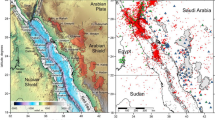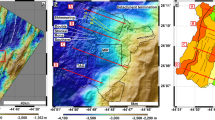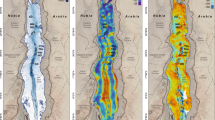Abstract
OUR understanding of the processes by which continents rift and sea-floor spreading initiates is derived primarily from studies either of old passive margins and oceanic crust or of young regions of intra-continental extension where spreading has not yet started. It has been thought that continental rifting ceases when sea-floor spreading begins1,2, that oceanic fracture zones develop from transfer or transform faults within continental rifts3,4, and that linear magnetic anomalies correlate with the onset of sea-floor spreading during times of magnetic reversals5,6. Here we present a marine geophysical survey of one of the few active examples of continental rifting and spreading initiation, the western Woodlark basin/ Papuan peninsula region of New Guinea, which shows that in detail these assumptions do not hold. The data confirm models of the rifting to spreading transition that invoke both ridge propagation and nucleation of discrete spreading cells7,10, and provide an unambiguous example of a spreading centre reorienting by synchronous jumping rather than propagation.
This is a preview of subscription content, access via your institution
Access options
Subscribe to this journal
Receive 51 print issues and online access
$199.00 per year
only $3.90 per issue
Buy this article
- Purchase on Springer Link
- Instant access to full article PDF
Prices may be subject to local taxes which are calculated during checkout
Similar content being viewed by others
References
Bolin, B. in The Greenhouse Effect, Climate Change, and Ecosystems (eds Bolin, B., Duos, B. R., Jeger, J. & Warrick, R. A.) 93–255 (SCOPE Rep. No. 29, Wiley, Chichester, 1986).
Gorham, E. Ecol. Applic. 2, 182–195 (1991).
Clymo, R. S. Phil. Trans. R. Soc. B303, 605–654 (1984).
Clymo, R. S. in Quaternary Landscapes (eds Cushing, E. J. & Shane, L. C.) 77–112 (Univ. Minnesota Press, Minneapolis, 1991).
Romanowicz, E. A., Siegel, D. I. & Glaser, P. H. Geology 21, 231–234 (1993).
Post, W. M. Rep. No. ORNL/TM-11457 (Oak Ridge National Lab., Oak Ridge, Tennessee, 1990).
Zehnder, A. J. B. Biology of Anaerobic Microorganisms (Wiley-Liss, New York, 1988).
Brock, T. D. & Madigan, M. T. Biology of Microorganisms (Prentice-Hall, Englewood Cliffs, 1991).
Aber, J. D. & Melillo, J. M. Terrestrial Ecosystems (Saunders Collage, Philadelphia, 1991).
Ingram, H. A. P., Rycroft, D. W. & Williams, D. J. A. J. Hydrol. 22, 213–218 (1974).
Rycroft, D. W., Williams; D. J. A. & Ingram, H. A. P. J. Ecol. 63, 535–568 (1975).
Boelter, D. H. & Verry, E. S. Gen. Tech. Rep. NC-31 (US Dept Agriculture Forest Serv., Washington DC, 1977).
Ingram, H. A. P. Nature 297, 300–303 (1982).
Ingram, H. A. P. in Mires: Swamp, Bog, Fen and Moore: General Studies 4A (ed. Gore, A. J. P.) 67–158 (Elsevier, Amsterdam, 1983).
Ivanov, K. E. Water Movement in Mires (Academic, London, 1991).
Chason, D. B. & Siegel, D. I. Soil Sci. 142, 91–99 (1986).
Bear, J. Dynamics of Fluids in Porous Media (Elsevier, New York, 1972).
Domenico, P. & Schwartz, F. Physical and Chemical Hydrogeology (Wiley, New York, 1990).
Siegel, D. I. Water Res. Inv. No. 81-24 (US Geol. Surv., Washington DC, 1981).
Siegel, D. I. J. Ecol. 71, 913–921 (1983).
Siegel, D. I. & Glaser, P. H. J. Ecol. 75, 743–754 (1987).
Siegel, D. I. in Patterned Peatlands of Northern Minnesota (eds Wright, H. E. Jr & Coffin, B. A.) 163–173 (Univ. Minnesota Press, Minneapolis, 1992).
Almendinger, J. C., Almendinger, J. E. & Glaser, P. H. J. Ecol. 74, 393–401 (1986).
Glaser, P. H., Janssens, J. A. & Siegel, D. I. J. Ecol. 78, 1021–1048 (1990).
Bennett, P., Siegel, D. I., Hill, B. & Glaser, P. H. Geology 19, 328–331 (1991).
Hill, B. M. & Siegel, D. I. J. Hydrol. 123, 211–224 (1991).
Boldt, D. R. thesis, Syracuse Univ. (1983).
Wang, H. F. & Anderson, M. P. Introduction to Groundwater Modeling: Finite Difference and Finite Element Methods (Freeman, San Francisco, 1982).
Huyakorn, P. & Pinder, G. F. Computational Methods in Subsurface Flow (Academic, New York, 1983).
Ours, D. P. thesis, Syracuse Univ. (1993).
Arevina, R. et al. Radiocarbon 35, 271–276, (1993).
Chanton, J. P. et al. (abstr.) Eos 74, 151 (1993).
Charman, D. J., Arevena, R. & Warner, B. G. J. Ecol. 82, 55–62 (1994).
Author information
Authors and Affiliations
Rights and permissions
About this article
Cite this article
Taylor, B., Goodliffe, A., Martinez, F. et al. Continental rifting and initial sea-floor spreading in the Woodlark basin. Nature 374, 534–537 (1995). https://doi.org/10.1038/374534a0
Received:
Accepted:
Issue Date:
DOI: https://doi.org/10.1038/374534a0
This article is cited by
-
Towards a process-based understanding of rifted continental margins
Nature Reviews Earth & Environment (2023)
-
Teleseismic P-Wave Tomography of the New Guinea-Solomon Arc System
Journal of Ocean University of China (2022)
-
Active hydrothermal vents in the Woodlark Basin may act as dispersing centres for hydrothermal fauna
Communications Earth & Environment (2022)
-
Continental break-up of the South China Sea stalled by far-field compression
Nature Geoscience (2018)
-
Coupled onshore erosion and offshore sediment loading as causes of lower crust flow on the margins of South China Sea
Geoscience Letters (2015)
Comments
By submitting a comment you agree to abide by our Terms and Community Guidelines. If you find something abusive or that does not comply with our terms or guidelines please flag it as inappropriate.



